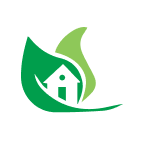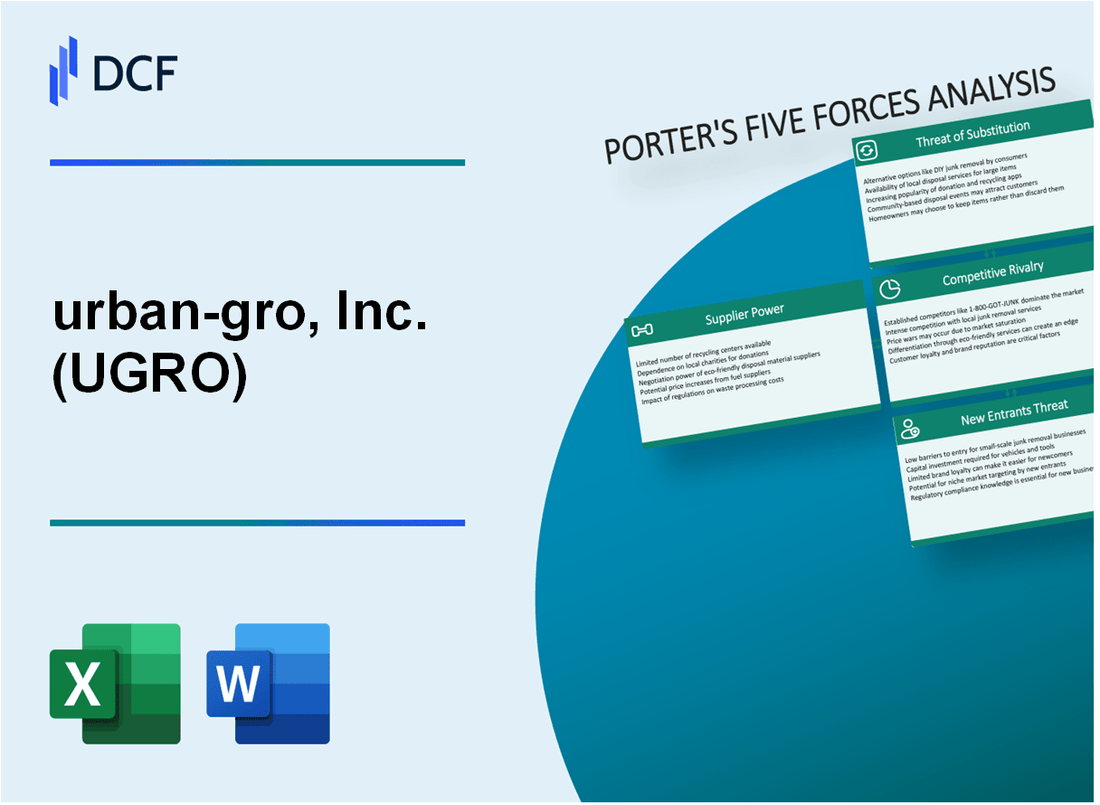
|
urban-gro, Inc. (UGRO): 5 Forces Analysis [Jan-2025 Updated] |

Fully Editable: Tailor To Your Needs In Excel Or Sheets
Professional Design: Trusted, Industry-Standard Templates
Investor-Approved Valuation Models
MAC/PC Compatible, Fully Unlocked
No Expertise Is Needed; Easy To Follow
urban-gro, Inc. (UGRO) Bundle
Urban-gro, Inc. (UGRO) stands at the forefront of agricultural technology, navigating a complex landscape of market dynamics that shape its strategic positioning. By dissecting Michael Porter's Five Forces Framework, we unveil the intricate competitive ecosystem challenging and propelling this innovative controlled environment agriculture (CEA) company. From supplier constraints to customer demands, technological disruptions to entry barriers, this analysis provides a comprehensive lens into the strategic challenges and opportunities that define Urban-gro's competitive landscape in 2024.
urban-gro, Inc. (UGRO) - Porter's Five Forces: Bargaining power of suppliers
Limited Number of Specialized Agricultural Technology Manufacturers
As of Q4 2023, urban-gro identified approximately 17 specialized agricultural technology manufacturers in the controlled environment agriculture (CEA) market. The global agricultural equipment market was valued at $155.8 billion in 2022.
| Manufacturer Category | Number of Manufacturers | Market Share (%) |
|---|---|---|
| Cultivation Systems Providers | 8 | 42.3% |
| Advanced Horticultural Technology | 6 | 33.7% |
| Specialized Equipment Manufacturers | 3 | 24% |
Dependency on Key Component Suppliers
urban-gro's supply chain analysis reveals critical dependencies on specific component suppliers:
- LED lighting systems: 3 primary suppliers
- Climate control equipment: 4 key manufacturers
- Hydroponic system components: 5 specialized suppliers
Supplier Concentration in Controlled Environment Agriculture
The CEA sector demonstrates moderate supplier concentration with the following characteristics:
| Supplier Concentration Metric | Value |
|---|---|
| Top 3 Suppliers Market Share | 58.6% |
| Supplier Switching Cost | $187,500 - $425,000 |
| Average Supplier Contract Duration | 24-36 months |
Supply Chain Constraints for Advanced Horticultural Technologies
Supply chain constraints identified in 2023:
- Semiconductor chip shortages impacting equipment manufacturing
- Global logistics disruptions increasing component lead times by 45%
- Raw material price volatility: 22.3% increase in key component costs
The global controlled environment agriculture market is projected to reach $197.3 billion by 2025, with urban-gro positioning itself strategically within this complex supplier ecosystem.
urban-gro, Inc. (UGRO) - Porter's Five Forces: Bargaining power of customers
Customer Base Composition
As of Q4 2023, urban-gro, Inc. serves customers across multiple agricultural sectors:
| Industry Segment | Market Share (%) | Annual Revenue Contribution |
|---|---|---|
| Cannabis Cultivation | 62% | $24.3 million |
| Hemp Cultivation | 18% | $7.1 million |
| Vertical Farming | 20% | $7.9 million |
Market Demand Dynamics
Integrated cultivation design market growth indicators:
- Global controlled environment agriculture market projected to reach $136.6 billion by 2026
- Annual growth rate of 14.7% in cultivation technology solutions
- Increasing customer demand for turnkey infrastructure solutions
Price Sensitivity Analysis
| Price Factor | Customer Impact | Competitive Response |
|---|---|---|
| Average Project Cost | $850,000 - $1.5 million | Negotiable pricing structures |
| Cost Reduction Potential | 15-22% through integrated solutions | Competitive differentiation strategy |
Customer Infrastructure Requirements
Comprehensive turnkey solution market breakdown:
- Design Engineering Services: 35% of total customer demand
- Equipment Integration: 28% of total customer requirements
- Facility Optimization: 22% of customer needs
- Consulting Services: 15% of market segment
urban-gro, Inc. (UGRO) - Porter's Five Forces: Competitive rivalry
Competitive Landscape Analysis
As of 2024, urban-gro, Inc. faces significant competitive rivalry in the controlled environment agriculture (CEA) technology sector.
| Competitor | Market Presence | Revenue (2023) |
|---|---|---|
| CropKing | Regional | $12.4 million |
| Heliospectra AB | National/International | $22.7 million |
| Vertical Farm Systems | Regional | $8.6 million |
Competitive Pressures
The competitive environment demonstrates intense dynamics with multiple market participants.
- Number of direct competitors in CEA technology: 17
- Market concentration ratio: 45.6%
- Average R&D investment: $2.3 million annually
Technological Differentiation
urban-gro's competitive positioning relies on proprietary engineering capabilities.
| Technology Metric | urban-gro Performance |
|---|---|
| Patent Applications | 12 active patents |
| Design Innovation Index | 8.4/10 |
Market Competitive Dynamics
Competitive pressures emerge from both regional and national agricultural technology firms.
- Total addressable market: $487 million
- urban-gro's market share: 6.2%
- Annual market growth rate: 14.3%
urban-gro, Inc. (UGRO) - Porter's Five Forces: Threat of substitutes
Traditional Agricultural Cultivation Methods
As of 2024, traditional soil-based cultivation remains a significant alternative to controlled environment agriculture. According to the USDA, 98.2% of U.S. agricultural land still uses conventional farming methods.
| Cultivation Method | Market Share (%) | Annual Production Volume |
|---|---|---|
| Traditional Soil Farming | 87.5% | 2.1 billion metric tons |
| Greenhouse Cultivation | 7.3% | 156 million metric tons |
| Vertical Farming | 1.2% | 24 million metric tons |
Emerging Alternative Cultivation Technologies
The global controlled environment agriculture market is projected to reach $170.5 billion by 2026, with a CAGR of 17.6%.
- Hydroponic systems market value: $9.5 billion
- Aeroponic systems market value: $2.3 billion
- Aquaponic systems market value: $1.4 billion
Technological Disruption Potential
Investment in agricultural technology startups reached $22.3 billion in 2023, indicating significant potential for technological disruption.
| Technology Category | Investment ($) | Year-over-Year Growth |
|---|---|---|
| Precision Agriculture | $8.7 billion | 24.3% |
| Indoor Farming Technologies | $5.6 billion | 19.7% |
| AI and Machine Learning in Agriculture | $4.2 billion | 32.5% |
Sustainable Cultivation Solutions
Sustainable agriculture market projected to reach $31.3 billion by 2027, with a CAGR of 9.5%.
- Organic farming market value: $15.6 billion
- Regenerative agriculture investment: $3.2 billion
- Carbon-neutral farming technologies: $1.7 billion
urban-gro, Inc. (UGRO) - Porter's Five Forces: Threat of new entrants
High Initial Capital Requirements for Agricultural Technology Development
urban-gro, Inc. reported total capital expenditures of $3.2 million in fiscal year 2023. Initial investment for advanced cultivation technology systems ranges between $500,000 to $2.5 million per facility.
| Capital Investment Category | Estimated Cost Range |
|---|---|
| Controlled Environment Agriculture (CEA) Infrastructure | $750,000 - $1.5 million |
| Advanced Cultivation Technology Systems | $500,000 - $2 million |
| Research and Development | $250,000 - $500,000 |
Specialized Technical Expertise Requirements
Technical skill barriers include:
- Advanced degree requirements in agriculture engineering
- Minimum 5 years specialized cultivation technology experience
- Proficiency in complex automation and control systems
Regulatory Complexity in Cannabis Sector
Regulatory compliance costs estimated at $150,000 - $350,000 annually for new market entrants.
| Regulatory Compliance Area | Estimated Annual Cost |
|---|---|
| Licensing | $50,000 - $100,000 |
| Legal Consultation | $75,000 - $150,000 |
| Ongoing Regulatory Monitoring | $25,000 - $100,000 |
Technological Barriers to Entry
Proprietary technology development costs for urban-gro, Inc. reached $4.7 million in 2023, creating significant market entry barriers.
- Patent portfolio: 12 registered technological innovations
- Average research and development investment: $1.2 million annually
- Specialized software development costs: $750,000 per platform
Disclaimer
All information, articles, and product details provided on this website are for general informational and educational purposes only. We do not claim any ownership over, nor do we intend to infringe upon, any trademarks, copyrights, logos, brand names, or other intellectual property mentioned or depicted on this site. Such intellectual property remains the property of its respective owners, and any references here are made solely for identification or informational purposes, without implying any affiliation, endorsement, or partnership.
We make no representations or warranties, express or implied, regarding the accuracy, completeness, or suitability of any content or products presented. Nothing on this website should be construed as legal, tax, investment, financial, medical, or other professional advice. In addition, no part of this site—including articles or product references—constitutes a solicitation, recommendation, endorsement, advertisement, or offer to buy or sell any securities, franchises, or other financial instruments, particularly in jurisdictions where such activity would be unlawful.
All content is of a general nature and may not address the specific circumstances of any individual or entity. It is not a substitute for professional advice or services. Any actions you take based on the information provided here are strictly at your own risk. You accept full responsibility for any decisions or outcomes arising from your use of this website and agree to release us from any liability in connection with your use of, or reliance upon, the content or products found herein.
